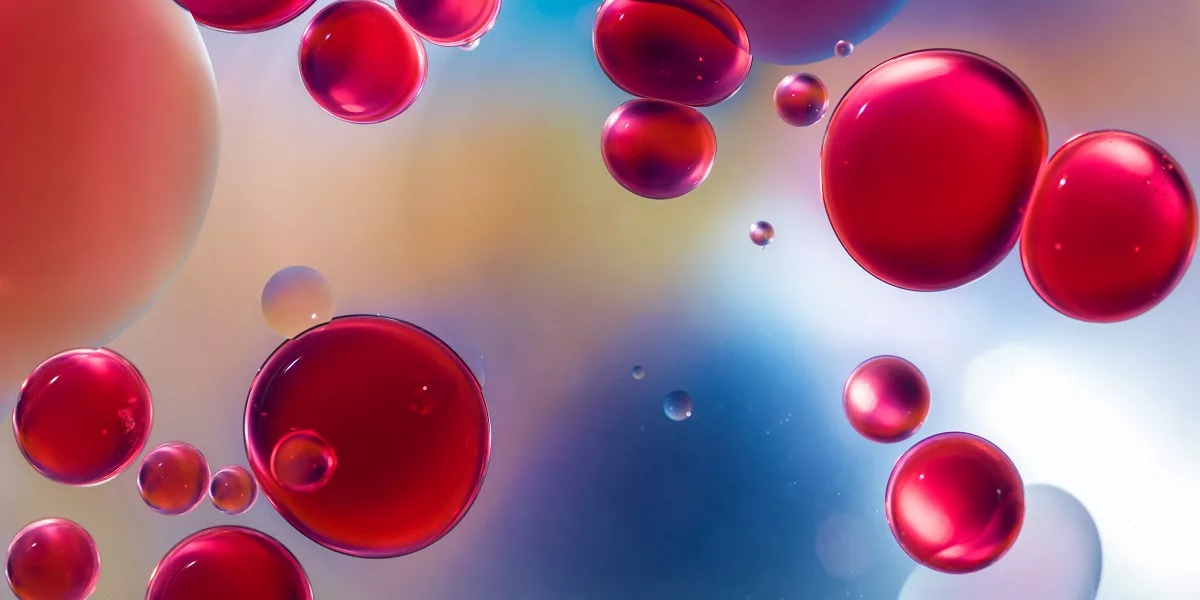A health condition that negatively affects the hemoglobin within the red blood cells is called sickle cell disease (SCD). It occurs due to a genetic mutation (change) that causes hemoglobin to clump together, which makes red blood cells turn sickle-shaped. These blood cells often cause blockages in the blood vessels. As a result, you may experience anemia, pain, infections, and other severe complications.
In general, SCD is the most common inherited blood disorder that negatively affects red blood cells. This condition negatively affects hemoglobin, which is an important protein that helps carry oxygen in the blood throughout the body.
In normal circumstances, red blood cells are round and flexible, which allows them to move easily through capillaries and deliver oxygen throughout the body. In people with SCD, red blood cells contain a changed form of hemoglobin called hemoglobin S. It causes changes in the shape of red blood cells, making them become rigid and stick together. This causes blockages in blood vessels, which limit oxygen-rich blood flow to multiple structures and organs in the body. As a result, you may experience serious complications, such as infections, organ damage or failure, moderate to severe pain, and others. Furthermore, these abnormal red blood cells do not last as long as healthy ones, which often leads to anemia. While sickle cell disease is a chronic health condition, you may need treatment to relieve the symptoms and improve your quality of life.
Types
Healthcare professionals have divided this disorder into several types according to the abnormal gene that a person inherits from their biological parents. For example:
Hemoglobin SS (HbSS)
This is a severe form of SCD, and it affects roughly 65% of people who have this inherited disorder. Those who develop this type of SCD have chronic anemia. It occurs when a person inherits two abnormal genes with hemoglobin S from each biological parent.
Hemoglobin SC (HbSC)
This type often affects approximately 25% of people with SCD, and it usually causes mild to moderate symptoms. In such cases, people also inherit one hemoglobin S gene from one biological parent and an abnormal hemoglobin C gene from another.
Hemoglobin (HbS) Beta Thalassemia
This type also occurs when a person inherits one hemoglobin S from one parent and one abnormal type, known as beta thalassemia, from another parent. Generally, there are two subtypes. For example:
- “Plus” (HbS beta +) – This form negatively affects roughly 8% of people with SCD, and it is a mild form.
- “Zero” (HbS beta 0) – In such cases, the condition affects about 2% of people with SCD, and it may cause more severe symptoms similar to hemoglobin SS disease.
However, there are other rarer forms, including hemoglobin SD (HbSD), hemoglobin SE (HbSE), and hemoglobin (HbSO).
This disorder negatively affects about 100,000 Americans, according to some research. It often occurs in 1 in every 365 Black births, 1 in every 16,000 Hispanic American births, and about 1 in every 12 people of Black or African descent carry the sickle cell trait.
What is Sickle Cell Trait?
This occurs when a person inherits only one abnormal hemoglobin S gene from one biological parent. In such cases, they become carriers that may pass this abnormal gene to their children in the future. Usually, people with sickle cell trait do not experience any symptoms. In rare cases, severe dehydration and intense physical activity may cause serious health problems in people, even with one abnormal gene.
Symptoms
Commonly, the symptoms begin when a child is about 5 years old. In any case, people with this disorder may experience different symptoms. Check below some examples:
- Frequent pain episodes
- Anemia that often leads to fatigue (extreme tiredness), weakness, and paleness
- Jaundice (yellowing of the skin and eyes)
- Painful swelling in the feet or hands
If you experience any of the previous symptoms, immediately contact your healthcare professional.
Causes
This condition occurs due to a genetic mutation (change) in the HBB gene. This gene is involved in the production of a part of hemoglobin. It often develops when a child receives two abnormal HBB genes from each biological parent (autosomal recessive inheritance).
Risk Factors
There are some groups of people who are more prone to develop SCD. For example:
- African descent (including African Americans)
- Hispanic Americans from South and Central America
- Mediterranean, Middle Eastern, Indian, and Asian descent
What Are The Potential Complications of Sickle Cell Disease?
Those who get two abnormal HBB genes and develop sickle cell disease may also experience some complications. Usually, complications of this disorder begin early and may continue for the rest of your life. Check below some examples:
Pain
This is one of the most common complications of SCD. It often occurs when blood vessels are blocked. Thus, blood flow is reduced, which causes pain. Sometimes, people may experience an acute pain crisis (also called sickle cell crisis), vaso-occlusive crisis (VOC), or vaso-occlusive episode (VOE). These pain crises often negatively affect the chest, back, legs, and arms. In rare cases, a person with SCD may develop chronic pain.
Anemia
Sickled cells live shorter compared to healthy red blood cells, which may lead to anemia. This condition occurs when you do not have enough red blood cells. The most common symptoms of anemia include lightheadedness, dizziness, irritability, and severe fatigue.
Acute Chest Syndrome
This complication is considered a medical emergency because it may cause a lung injury, trouble breathing, and reduced oxygen levels in the body.
Blood Clots
There is an increased risk of developing blood clots in people with sickle-shaped blood cells. Therefore, you may develop deep vein thrombosis (DVT), pulmonary embolism (PE), and other life-threatening conditions.
Stroke
This complication often occurs when sickled cells block blood vessels that supply the brain with oxygen-rich blood. However, strokes are more common in people with sickle cell anemia.
Vision Problems
This condition may also cause vision disorders due to blocked blood flow in the vessels in the eyes. In most cases, blockages occur in the retina. Regular eye checkups are recommended because this complication does not cause symptoms until sudden vision loss occurs, which may lead to permanent blindness without immediate treatment.
Priapism
The abnormal red blood cells may also cause persistent and painful erections, which may lead to permanent erectile dysfunction (ED). If priapism lasts more than 5 hours, it is considered a medical emergency.
Organ Damage and Failure
In most cases, people with SCD are at increased risk for problems with the lungs, heart, kidneys, and other organs. It occurs due to reduced oxygen levels in the blood. Rarely, it may lead to multiple organ failure.
Unfortunately, there is no way to prevent this condition. However, you can perform genetic tests to determine whether you have this abnormal gene or not. It is very important to understand the risks of having children with sickle cell disease.
Diagnosis
In general, U.S. hospitals test all babies for sickle cell disease during routine newborn screenings. To perform this genetic test, doctors take a sample of blood. To confirm the diagnosis, doctors need a hemoglobin electrophoresis.
Sometimes, doctors may diagnose sickle cell disease during pregnancy by performing amniocentesis and chorionic villus sampling.
Treatment
Usually, physicians prescribe medicines, blood transfusions, bone marrow transplants, and gene therapies for people with SCD. However, the treatment often begins with antibiotics that help prevent infections, especially in children under 5 years old.
Medicines
The following medications often help people with SCD reduce the symptoms and improve their quality of life. For example:
- Voxelotor – This medicine is used to prevent sticking and binding of the red blood cells. It may also decrease the destruction of some red blood cells, which helps improve blood flow to the organs and reduces the risk of anemia.
- Crizanlizumab – It helps prevent sticking of the red blood cells to the blood vessel walls, which helps reduce inflammation and pain crises.
- Hydroxyurea – This medication is used to reduce the risk of complications such as chronic pain, acute chest syndrome, and severe anemia.
- L-glutamine – This is a painkiller used to reduce the number of pain crises you experience. In some cases, doctors may recommend nonsteroidal anti-inflammatory drugs (NSAIDs) and opiates.
Transfusions
This treatment is often recommended by doctors to treat and prevent SCD complications. This procedure may include:
- Acute transfusions – It is often used to treat complications that may lead to severe anemia. Moreover, acute transfusions may also help reduce the risk of strokes, acute chest syndrome, and organ failure.
- Red blood cell transfusions – During this procedure, doctors try to increase the number of healthy red blood cells in the body.
Stem Cell Transplant
This treatment is also known as a blood or bone marrow transplant, and it may help cure the condition. However, this treatment is not an option for everyone. Consult with your healthcare professional about the risks and benefits of this treatment.
Gene Therapy
Nowadays, researchers are testing gene therapy to treat sickle cell disease. It helps correct the abnormal hemoglobin gene and inserts a healthy gene into a person’s stem cells. According to some studies, this treatment may be a routine treatment for people with SCD.
Frequently Asked Questions
What is the difference between sickle cell anemia and sickle cell disease?
SCD is an umbrella term for multiple types of sickle cell disorders, but sickle cell anemia is a type of SCD. Sickle cell anemia also means the most severe anemia.
Does sickle cell trait or sickle cell disease affect pregnancy?
While most people with SCD have healthy pregnancies, the risks of complications are higher. These include hypertension (high blood pressure), blood clots, miscarriage, low birth weight, and premature birth.
Is there a cure for sickle cell disease?
The only way to cure this inherited disorder is a stem cell transplant that requires a healthy donor who matches genetically (such as a sibling). However, this is not an option for everyone. Ask your healthcare professional if you have any other questions.




